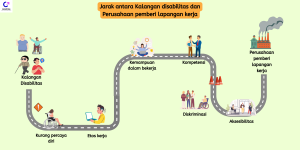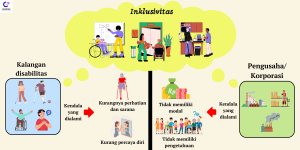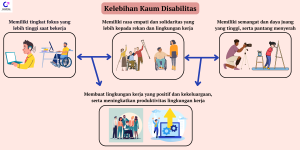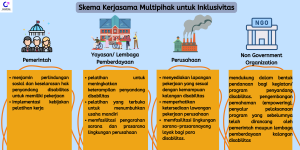Inclusivity is a topic that we are starting to hear more and more often both in social media and in everyday life. This topic is usually often expressed by civil society organizations, non-governmental organizations as well as the government at the ministerial, provincial, city and village government levels. Inclusivity has the root word inclusion which means to include. Thus, inclusivity literally invites all of us to include every individual regardless of their background. Of course, it is not necessarily to include someone without clarity of contribution, but rather for the community to find a system where anyone can contribute as long as they find the right place and with the right role. Inclusivity in the context of disability aims to provide equal opportunities and treatment for people with disabilities in society, especially in education and the world of work.
Realizing inclusivity in the world of work is not without challenges because the message of inclusivity has only received global and national attention in the last ten years so it is still not widely applied to the world of work, especially in non-urban environments. Although it has often been heard and the government has made / has regulations related to inclusiveness, reality shows that inclusiveness in the work environment for people with disabilities is still full of challenges.
As a result, there are still many people with disabilities who have not been absorbed by the industry due to the lack of opportunities provided by companies providing employment. This condition makes many people or communities moved to fight for the rights of people with disabilities in getting decent work. Concrete activities carried out include creating movements or non-profit organizations. However, the efforts made by movements and non-profit organizations to realize inclusiveness in the work environment are still specific, which means that they are only successful in one place and cannot be applied in other companies or companies in general. This happens because the application of inclusiveness requires companies that are very accommodating and committed to the success of disability inclusiveness. Whereas the mindset of entrepreneurs in general is to increase competitiveness and business growth. Meanwhile, to be able to succeed inclusivity, it is necessary to minimize or even eliminate the distance of needs and expectations between the company and people with disabilities.

Figure 1 Distance between Disabled Workers and Employers
This article attempts to 1) map issues related to inclusiveness, especially related to disability, 2) identify the gap between employers and people with disabilities, 3) describe the obstacles experienced/encountered by employers and people with disabilities, 4) highlight the advantages and positive impacts of workers with disabilities, 5) convey the efforts that have been made by relevant stakeholders and 6) propose a cooperation scheme from stakeholders to encourage the creation of a successful/effective disability inclusiveness implementation system/platform.
Definition
Inclusiveness can be defined as a recognition and appreciation of the existence of differences and diversity. For example, people with disabilities or people with special needs must be treated equally, not discriminatory and arbitrary, and get respect and appreciation. In other words, Inclusivity allows all employees to have equal opportunities, with full confidence when doing activities. Inclusivity in the world of work also means opening up the widest possible opportunities for all people, including those with disabilities.
Statistics
The Ministry of Manpower has recorded that only 1.73 percent of companies recruit and employ people with disabilities, which amounts to around 969 companies. The initiator of the Disability Vocational Training Center program as well as the President’s Special Staff, Angkie Yudistia, said that the Ministry of Manpower’s data showed that only 0.02 percent or 3,433 workers with disabilities were absorbed into the labor market. This figure shows that the number of people with disabilities in Indonesia is 22.98 million, with 16.5 million of them being of productive working age. Based on data from the Ministry of Manpower, it can be concluded that the implementation of inclusiveness for people with disabilities in the work environment is still far from the Government’s expectations as stated in Law Number 8 of 2016.
Obstacles
The low rate of employment of workers with disabilities is estimated to occur due to obstacles experienced both from the side of the disability and companies providing employment.
Obstacles experienced by prospective workers with disabilities
People with disabilities often find discriminatory requirements that are often included in job vacancies, one of which is requirements related to age limits for job applicants. Discriminatory requirements cause people with disabilities to have low self-confidence and lose their fighting spirit. This condition is exacerbated by the government’s inadequate attention to people with disabilities. The municipal government regularly organizes training and workshops for people with disabilities, but the training is still very limited. Participants are invited only when there are many other individuals with disabilities who need to be included. In addition, when a person with a disability gets a job, they are hampered by transportation facilities or roads, making it difficult for them to reach the workplace safely and comfortably.
The low rate of employment of workers with disabilities is estimated to occur due to obstacles experienced both from the side of the disability and companies providing employment.
Obstacles experienced by prospective workers with disabilities
People with disabilities often find discriminatory requirements that are often included in job vacancies, one of which is requirements related to age limits for job applicants. Discriminatory requirements cause people with disabilities to have low self-confidence and lose their fighting spirit. This condition is exacerbated by the government’s inadequate attention to people with disabilities. The municipal government regularly organizes training and workshops for people with disabilities, but the training is still very limited. Participants are invited only when there are many other individuals with disabilities who need to be included. In addition, when a person with a disability gets a job, they are hampered by transportation facilities or roads, making it difficult for them to reach the workplace safely and comfortably.
On the other hand, when there are generous employers who are willing to hire people with disabilities, their intentions are often underappreciated and they are often taken advantage of. However, there are also companies that are only interested in hiring people with disabilities in the hope of getting cheap labor. This mindset is also not good and needs to be opened up, because a productive workforce cannot be seen from its condition whether perfect or disabled but from its professionalism, willingness, enthusiasm, ethics, and gratitude.

Figure 2 Obstacles to implementing inclusiveness in the work environment
Gap between potential workers with disabilities and employers.
The obstacles experienced by employers and people with disabilities create a gap, so they can only blame each other. People with disabilities think that employers are not willing to embrace people with disabilities, while employers are not unwilling to embrace people with disabilities, but they are constrained either by a lack of knowledge or capital to create an inclusive work environment. If this situation is allowed to continue, the distance between the two parties will remain unresolved.
A question arises “what if these two parties, namely companies providing jobs and people with disabilities, are mediated by several stakeholders”. The mediator will help bring together job providers and job seekers with disabilities through a middle ground. People with disabilities can better understand what employers feel and try to improve their skills and professionalism. Companies that provide jobs can also review the requirements for recruiting workers so that they do not appear to be discriminatory against people with disabilities. When everything can be communicated, it is not impossible that inclusiveness in the world of work for people with disabilities can be realized. Companies that provide jobs are also helped by more performance from workers with disabilities, people with disabilities get jobs, can self-actualize and become prosperous.
Government Efforts
The central government’s effort to promote inclusiveness for persons with disabilities is by issuing Law Number 8 of 2016 concerning persons with disabilities. This law is a manifestation of the Government’s steps in fulfilling equal opportunities for persons with disabilities in all aspects of state and community administration, respect, protection, and fulfilment of the rights of persons with disabilities, including the provision of accessibility and proper accommodation. In Law No. 8/2016 Article 53 paragraph 1 states that the central government, local governments, BUMN, and BUMD are obliged to employ persons with disabilities at least 2 percent of the number of employees or workers. Meanwhile, paragraph 2 states that private companies are obliged to employ at least 1 percent of persons with disabilities from the number of employees or workers.
The government in various regions has also conducted a lot of training for people with disabilities through the Job Training Center (BLK) in each region. The purpose of this training is none other than to make people with disabilities skilled and ready to work. When more and more people with disabilities are ready to work, the absorption rate of workers with disabilities will automatically increase and companies providing jobs will get more workers.
Non-Governmental Organization Efforts
In addition to government efforts, efforts to realize inclusiveness for people with disabilities have actually been initiated by several parties, such as Kerjabilitas.com, and Non-Governmental Organizations (NGOs) such as Rumah Disabilitas and Thisable Enterprise.
Kerjabilitas.com is a social career network that connects people with disabilities to inclusive employers in Indonesia. Non-Governmental Organization (NGO) Rumah Disabilitas is a national organization that fights for the rights of people with disabilities. Another NGO, Thisable Enterprise, is an organization that accommodates and empowers people with disabilities to have skills, and channel them into the world of work.
The advantages of a disabled workforce
According to Angkie Yudistia, people with disabilities have advantages, namely workers with disabilities have a level of focus that is more than the average person and are highly dedicated, besides that people with disabilities also tend to chat less so that their productivity can be better than non-disabled people. Disabled workers are also more loyal to the company and rarely resign. People with disabilities who lose one of their senses, the other senses will have higher strength than normal people. For example, a blind person usually has reflexes above the average normal person. Disabled people also have high empathy and solidarity with the environment and coworkers, bringing a positive atmosphere in the work environment.
With the advantages that can be provided by people with disabilities, they should get more attention from companies that provide employment. The advantages possessed by people with disabilities are able to create a positive and inclusive work environment, so as to increase company productivity. With their positive impact, they have proven that they can also be valuable assets of a company, and become a reason to make many companies providing employment not afraid to recruit workers with disabilities.

Figure 3 Pros and cons of people with disabilities in the workplace
Proposal
The implementation of inclusiveness for people with disabilities in the work environment is still a complex matter because it is still relatively new in the world of work in Indonesia. Therefore, to encourage more inclusive work environments, a proposed scheme involving several stakeholders and policy makers is needed.
Parties and Efforts that can be done by stakeholders
Parties that need to be involved in this scheme include 1) The government (central, regional and city governments), 2) foundations or institutions empowering people with disabilities, 3) companies providing employment and also 4) NGOs. The 4 parties mentioned are interrelated in realizing inclusiveness in the work environment.
Each party must contribute to each other and cooperate in providing job vacancies for people with disabilities, office environment facilities that are friendly to workers with disabilities. The government has an important role in the employment sector to ensure social protection and alignment of the rights of persons with disabilities to have a job by giving special attention. The government can strive with examples such as the implementation of job training policies, facilitating job placement in companies.
Foundations or institutions empowering people with disabilities contribute by holding programs that aim to prepare people with disabilities to become competent disability workforce candidates in the world of work, improving the skills of people with disabilities. The form of programs held, for example, such as training that is open to persons with disabilities, not only training for the world of work, but the provision of training that is to foster independent businesses for persons with disabilities can also be carried out where these activities are intended for workers with disabilities who want independent businesses and then develop in a community group so as to provide wider job vacancies to increase these businesses or what is commonly known as SMEs (Small and Medium Enterprises), Not only that, the foundation can also facilitate briefings to companies regarding what facilities and infrastructure need to be considered in the company environment for workers with disabilities so as to create a decent work environment for people with disabilities.
Companies provide jobs that are in accordance with the abilities of people with disabilities by paying attention to the skills needed by the company, paying attention to the availability of job vacancies, and companies must facilitate the infrastructure environment for people with disabilities.
NGOs or Non Government Organizations can take a role by supporting in the form of funding for activities/programs for persons with disabilities, developing understanding (empowering), channelling the implementation of programs that have previously been designed by the government and empowerment institutions for persons with disabilities. The roles of all these parties are explained by the scheme in Figure 4.

Figure 4 Schematic of Multi Stakeholder Cooperation for Inclusiveness
Success Story
A success story of inclusivity in the workplace is a movement made by a large Japanese fashion retail company operating in Indonesia. This Japanese retailer has opened opportunities for people with disabilities to work as store backroom staff. In the future, this Japanese fashion retail company will provide more opportunities for various positions that are in accordance with the abilities of people with disabilities.
In addition to the application of inclusiveness in Japanese fashion retail companies, a success story of the application of inclusiveness in the work environment occurred in a coffee shop in Jakarta that employed 7 employees with Down syndrome under the auspices of the Association of Parents of Children with Down Syndrome (POTADS) community and were recruited by the coffee shop to work as baristas and waiters.
Another example of a success story of implementing inclusivity in the work environment is shown by The Able Art, a social enterprise that reproduces paintings by disabled artists into fashion products. They are committed to promoting disability inclusion by providing employment opportunities for people with disabilities, ensuring that they have access to their rights, including copyright and providing opportunities to collaborate with disabled artists and receive a fair share of profits.
Through this paper, it is hoped that it can further open the perspectives of each stakeholder and invite stakeholders to contribute according to their roles to obtain a win-win solution in Realizing Inclusivity in the work environment.
References:
https://gajigesa.com/lingkungan-kerja-inklusif
https://www.rri.co.id/nasional/167018/kemnaker-catat-perusahaan-rekrut-disabilitas-masih-rendah
https://www.republika.id/posts/48485/nyala-semangat-pekerja-disabilitas-di-tengah-gemuruh-stigma
https://pattiro-semarang.org/2021/02/umkm-penyandang-disabilitas-harus-lebih-dilibatkan
https://www.liputan6.com/disabilitas/read/5164644/3-tantangan-pelaku-usaha-menuju-inklusi-disabilitas
https://formasidisabilitas.id
https://www.genpi.co/gaya-hidup/50895/kiprah-angkie-yudistia-besarkan-komunitas-pemberdayaan-disable
https://www.liputan6.com/health/read/2953433/keajaiban-yang-hanya-bisa-dirasakan-orang-buta
https://www.idntimes.com/life/inspiration/fajarnurmanto/pelajaran-yang-bisa-kamu-dapat-dari-kaum-berkebutuhan-khusus
https://www.uniqlo.com/id/en/news/topics/2021120301
https://visual.republika.co.id/berita/s533ir283/penyandang-down-syndrome-bekerja-sebagai-barista-dan-pramusaji-di-kafe-ini
https://ukmindonesia.id/baca-deskripsi-posts/lingkungan-kerja-ramah-difabel-begini-5-cara-menuju-bisnis-yang-lebih-inklusi
